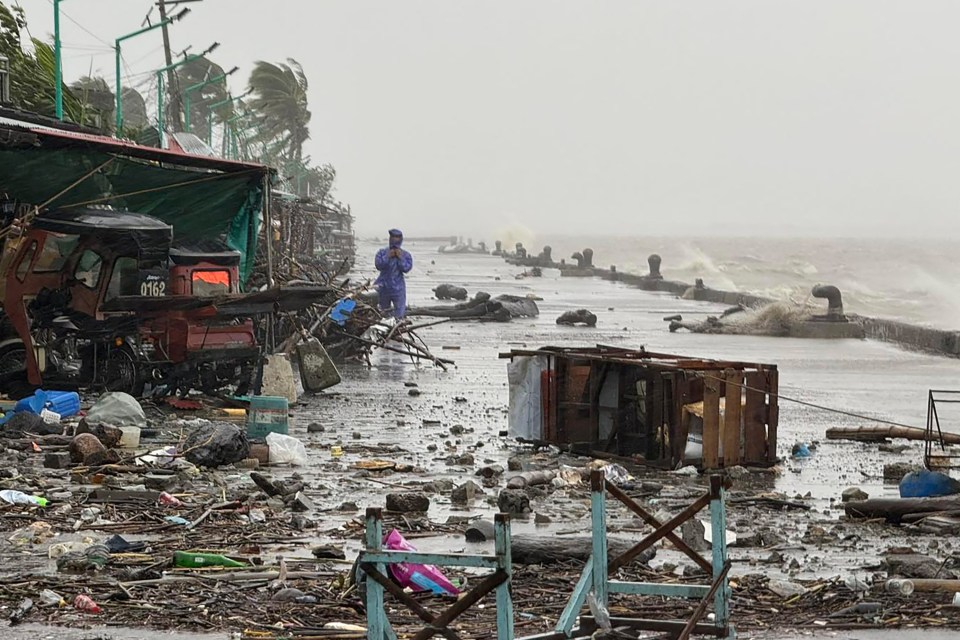A MONSTER super typhoon packing 137mph winds has slammed into the Philippines.
Super Typhoon Ragasa is the strongest storm to hit the region in years, grounding hundreds of flights, knocking out power and sparking mass evacuations across East Asia.
AFPA man stands near debris on a waterfront road due to weather patterns from Super Typhoon Ragasa in Aparri town, Philippines[/caption]
EPAA Filipino walks through heavy rain in Manila[/caption]
It tore through the Philippines’ northern islands before roaring west across the South China Sea towards Taiwan, Hong Kong, Macau and southern China.
The Category 5 storm, named after the Filipino word for “rapid motion”, is lashing Calayan Island and Apayao province, leaving thousands without electricity.
More than 8,200 people were evacuated in Cagayan, with 1,220 sheltering in emergency centres.
Schools and offices were suspended in Manila and 29 provinces, with flood warnings in place.
The Philippines’ weather bureau warned of a “high risk of life-threatening storm surge with peak heights exceeding three metres (nearly 10 feet) within the next 24 hours” in Cagayan, Batanes and Ilocos.
In Hong Kong, officials braced for what could be the city’s worst storm since Hato in 2017 and Mangkhut in 2018.
“Ragasa will pose a serious threat to Hong Kong, which could reach the levels of Hato in 2017 and Mangkhut in 2018,” warned deputy leader Eric Chan.
Residents scrambled to stock up on food and supplies, leaving shelves bare.
Zoe Chan, who runs a clothes shop in Wanchai, said: “The most important thing is to take better precautions, so I can rest easier.”
Hong Kong Observatory issued its third-highest warning, the T8 signal, shutting down businesses and transport.
The Airport Authority confirmed “significant disruption to flight operations” from Tuesday evening, with over 500 Cathay Pacific flights cancelled.
Qantas also said Hong Kong International Airport will suspend passenger flights for 36 hours.
In nearby Shenzhen, 400,000 people were ordered to evacuate coastal zones, with schools, offices and public transport shuttered.
Supermarkets in both Shenzhen and Hong Kong were stripped bare of bread, vegetables and fresh meat.
Taiwan scrapped domestic flights and suspended 88 ferry services, while Guangzhou announced all trains would halt Wednesday.
The Hong Kong Jockey Club cancelled its Wednesday race meeting, while schools across the city will remain closed for at least two days.
APPeople watch as strong waves batter Basco, Batanes province, northern Philippines[/caption]
EPACoastguard personnel conducting a rappel rescue in flood-hit municipality of Salcedo, Ilocos Sur province, Philippines[/caption]
AFPA man walks along a road amid heavy rain due to Super Typhoon Ragasa in Lal-lo town, Cagayan province[/caption]
Authorities have also opened 46 temporary shelters for residents in low-lying areas.
In southern China, major tech and financial hubs braced for impact, with offices in Shenzhen and Guangzhou telling workers to stay home.
Rail services across Guangdong province are being halted to prevent accidents.
Scientists warn storms like Ragasa are only getting fiercer as climate change heats the oceans.
With Ragasa’s winds howling at over 168mph at its peak, it is already being compared to 2021’s Typhoon Rai – which killed more than 400 people in the Philippines.
So far, no casualties have been confirmed.
But across Asia, millions are hunkering down for what could be the deadliest storm of the year.
AlamyA person holding an umbrella walks pass barricades filled with water and sandbags as Hong Kong prepares ahead of the massive storm[/caption]
AlamyTapes on the glass doors at a shopping mall in Tseung Kwan ahead of Super Typhoon Ragasa[/caption]

